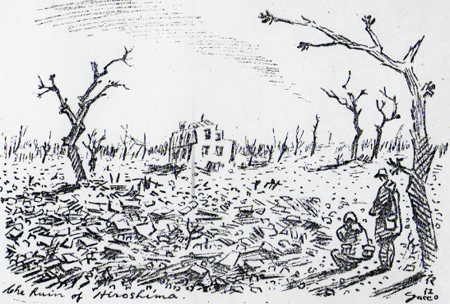|
Hiroshima, City of Horror

Text by Alvin Grauer. Illustration by Takamori Yakko"This is a view of Hiroshima a few days after the Atomic Age began and the Pacific war had ended. It is not pretty.
In 1941 Hiroshima was a neat little industrial and communications city of 300,000 in Southern Honshu, on Japan's Inland Sea. After the Atomic bomb (Genshi Baku-dan) in late 1945, 94,000 of its people were gone from the face of the earth, and half the city was gone with them. It happened so fast hundreds of bare, burned trees still remained, among the shattered roof tiles, their arms raised in mute pleading the war be ended soon. Their plea was answered when Japan, a few days later, threw in the sponge.
In effect, the nuclear fission bomb was the inevitable reply to another--the one bomb that fifteen years earlier blew up a few rail ties in Mukden and was followed miraculously by hundreds of Japanese soldiers pouring across the Chinese border. This kind of business was followed by aggression in Shanghai, and Nanking; then, when the "peace" in Asia was going good came the shattering attack on Pearl Harbor. The militarists of Japan pledged, without asking, Japan's 75,000,000 souls, her farms, and factories and cities, great and small. The people, and the cities were to be the pawns, in a game of World Conquest. Hiroshima was one of those pawns. Many Americans are sorry it had to be taken.
John Hersey in his famous "New Yorker" article has told in-detail the horror of that day. But shortly after the explosion Hiroshima looked no worse than Asakusa-ku, in Tokyo, where also in one afternoon (March, 1945) nearly 100,000 died in flames. The Tokyo raid required 450 planes, and Hiroshima only one--that's what gives one pause!
Today, Hiroshima citizens are staging a great comeback. Homes are being built on the ruins--stores being opened--new hope fills the air in an Age of Peace. Truly, great plans are Afoot--some say the city will emerge as the finest and most modern in Japan. Up 'n Atom!"
From: Grauer, Alvin. So I went to Japan. Tokyo: Nippon Times, 1947.
|
